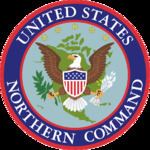Active 2002–present Founded 2002 | Nickname(s) USNORTHCOM, NORTHCOM | |
 | ||
Type of business Unified Combatant Command; Joint activity Profiles | ||
United States Northern Command (USNORTHCOM) is a Unified Combatant Command of the U.S. military tasked with providing military support for civil authorities in the U.S., and protecting the territory and national interests of the United States within the contiguous United States, Alaska (not Hawaii), Puerto Rico, Canada, Mexico, The Bahamas, and the air, land and sea approaches to these areas. It is the U.S. military command which, if applicable, would be the primary defender against a mainland invasion of the United States.
Contents
- Creation
- Mission
- Area of responsibility
- Headquarters
- Subordinate Commands
- List of commanders
- Planning and strategy
- Domestic operations and training
- Related legislation
- References
USNORTHCOM was created on 25 April 2002 when President George W. Bush approved a new Unified Command Plan, following the September 11 attacks. USNORTHCOM went operational on 1 October 2002.
The support that USNORTHCOM provides to civil authorities is legally limited by the Posse Comitatus Act, which sets some limits on the role of the U.S. military in civilian law enforcement. However, in case of national emergency, natural or man-made, its Air Forces Northern National Security Emergency Preparedness Directorate will take charge of the situation or event.
Creation
USNORTHCOM was established on 25 April 2002 when President George W. Bush approved a new Unified Command Plan, and attained initial operating capability on 1 October 2002.
Mission
According to the UCP, Northern Command's mission is to:
Area of responsibility
USNORTHCOM’s Area of Responsibility (AOR) includes air, land and sea approaches and encompasses the contiguous United States, Alaska, Canada, Mexico and the surrounding water out to approximately 500 nautical miles (930 km). It also includes the Gulf of Mexico, the Straits of Florida, portions of the Caribbean region to include The Bahamas, Puerto Rico, the U.S. Virgin Islands, the British Virgin Islands, Bermuda, and the Turks and Caicos Islands. The commander of USNORTHCOM is responsible for theater security cooperation with Canada, Mexico, and The Bahamas. In May 2011, NORTHCOM was mobilized in the wake of the BP oil spill in the Gulf of Mexico to provide air, ground, and logistical support. In October 2014, NORTHCOM took administrative control of Alaskan Command.
Headquarters
Commander, U.S. Northern Command is concurrently Commander of the U.S.-Canadian North American Aerospace Defense Command (NORAD). The two are co-located at Peterson Air Force Base in Colorado Springs, Colorado. General Ralph Eberhart was the first CDRUSNORTHCOM.
USNORTHCOM headquarters has approximately 1,200 uniformed and civilian members, and few permanent forces. Forces from all branches of the U.S. military may be assigned to the Command as needed to complete its mission.
Subordinate Commands
USNORTHCOM exercises command and control of two subordinate unified commands, four service component commands, and several standing Joint Task Forces (JTFs). The subordinate unified commands are Special Operations Command-North, which was activated on 31 December 2012, and Alaskan Command, which was transferred from US Pacific Command (USPACOM) control to USNORTHCOM control on 1 October 2014. USNORTHCOM service components include U.S. Fifth Army/ARNORTH, First Air Force/AFNORTH, United States Fleet Forces Command, and U.S. Marine Corps Forces Reserve/MARFORNORTH. USNORTHCOM's Joint Task Forces include Joint Force Headquarters National Capital Region, Joint Task Force-Civil Support, and Joint Task Force North.
Between 1 October 2002 and 2007, Northern Command deactivated Joint Force Headquarters Homeland Security and activated Joint Force Headquarters National Capital Region and Standing Joint Task Force North. On 31 December 2012, Special Operations Command-North was activated, and will be led by a general instead of a colonel.
List of commanders
Note: The National Defense Authorization Act of 2008 stipulates that at least one deputy commander of USNORTHCOM be a National Guard general officer unless the commander is already such an officer.
Planning and strategy
Northern Command has created several classified "concept plans" (e.g. "Defense Support of Civil Authorities") that are intended to address the 15 National Planning Scenarios that NORTHCOM must be prepared to respond to.
However the GAO found that the national strategy to defend the United States is several years out of date.
Domestic operations and training
NORTHCOM operates extensive domestic intelligence operations which both share and receive information from local, state and federal law enforcement agencies. Employees of the Federal Bureau of Investigation, Central Intelligence Agency, National Security Agency, Defense Intelligence Agency, National Geospatial-Intelligence Agency, and other agencies maintain offices at NORTHCOM and receive daily intelligence briefings.
Northern Command has completed several joint training exercises with local, state and federal law enforcement agencies, the Department of Homeland Security, and the Federal Emergency Management Agency (FEMA).
In Exercise Vigilant Shield 2008, Northern Command, Pacific Command, the Department of Homeland Security, and numerous law enforcement agencies across the U.S. conducted exercises to test their "response abilities against a variety of potential threats".
Related legislation
The Military Commissions Act of 2006 lifted many restrictions placed on the military to support civilian administration by the Posse Comitatus Act, however the US Supreme Court ruled in June 2008 that significant portions of the MCA were unconstitutional. The "John Warner Defense Authorization Act of 2007" H.R. 5122 (2006) effectively nullified the limits of the Insurrection Act when it was passed; however, the bill was amended in 2008.
On 1 October 2008, the 3rd Infantry Division’s 1st Brigade Combat Team was assigned to U.S. Northern Command, marking the first time an active unit had been given a dedicated assignment to Northern Command. The force will be known for the first year as a CBRNE Consequence Management Response Force, and will serve as an on-call federal response force for terrorist attacks and other natural or manmade emergencies and disasters.
